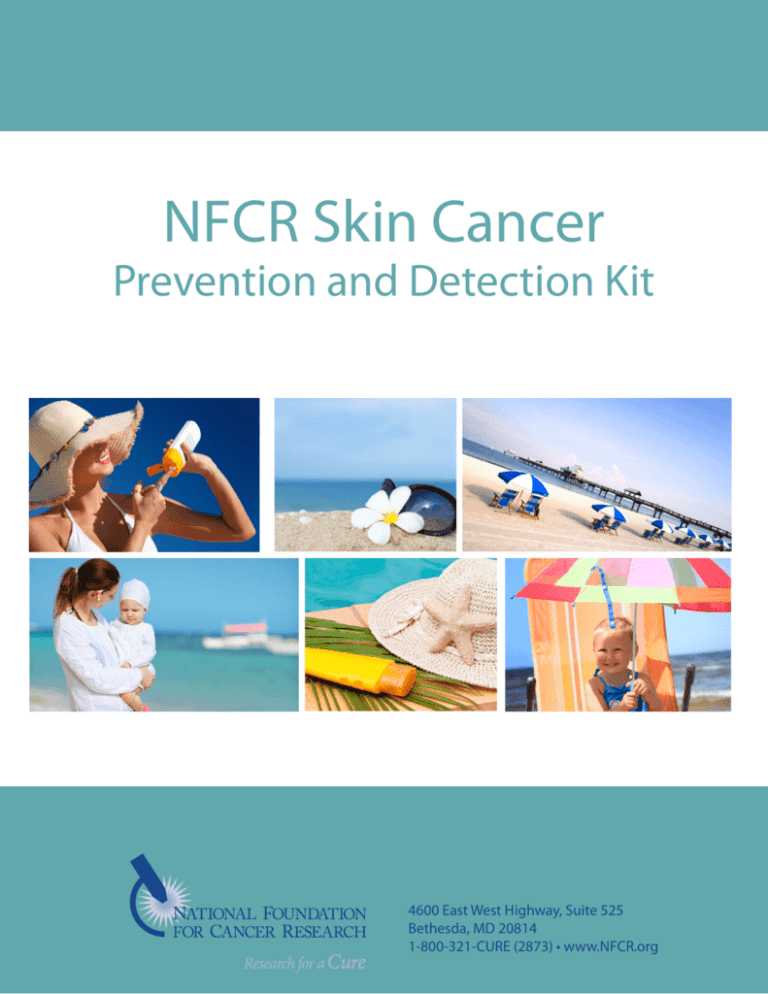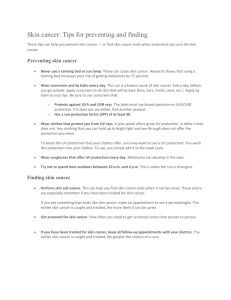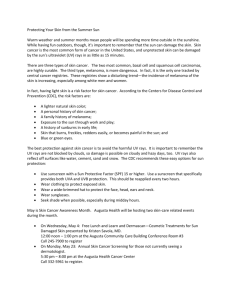NFCR Skin Cancer - National Foundation for Cancer Research
advertisement

NFCR Skin Cancer Prevention and Detection Kit 4600 East West Highway, Suite 525 Bethesda, MD 20814 1-800-321-CURE (2873) • www.NFCR.org INTRODUCTION Skin cancer is the most common type of cancer in the United States. A recent report estimated that more than 3 million Americans are diagnosed every year with skin cancer (both non-melanoma and melanoma are included).* Among those skin cancer patients, more than 76,000 are diagnosed with melanoma, the most serious form of skin cancer. But many of these cases could have been prevented! Studies have shown that much of the skin damage that leads to skin cancer is caused by overexposure to Ultraviolet (UV) rays from either the sun or from tanning beds. This damage is easily preventable. Keep reading the NFCR Skin Cancer Prevention and Detection Kit to learn our recommended ways to protect yourself and your family from skin cancer. Share this important information with those you care for to help them lead a healthier skin cancer-free life. TYPES OF SKIN CANCER Named for the class of skin cells affected, there are 3 main types of skin cancer Basal Cell – Most common form of skin cancer »» »» »» »» »» Estimated to be 80% of skin cancer cases each year Arises in tiny basal cells of the upper layer of skin, the epidermis Usually discovered on the face, ears, lips, and around the mouth. Rarely spreads, not fatal, but can be highly disfiguring from surgical removal of large tumor Men are about twice as likely as women to have basal cell cancers (likely due to higher levels of sun exposure) Squamous Cell – Second most common skin cancer »» »» »» »» »» »» Estimated to be 20% of skin cancer cases each year Forms in the flat scale-like squamous cells of the epidermis Typically found on the face, ears, lips, mouth, neck, hands, arms and back. Can spread to other parts of the body. With early treatment, is 95 percent curable. Rarely appears before age 50 and is most often seen in individuals in their 70s. Men are about 3 times as likely as women to have squamous cell cancer (likely due to higher levels of sun exposure) »» The majority of skin cancers in African-Americans are squamous cell carcinomas, usually arising on the sites of preexisting inflammatory skin conditions or burn injuries. * American Cancer Society, 2012 1 Melanoma – Accounts for less than 5% of skin cancer cases – but it causes most skin cancer deaths. In 2012, it is estimated that more than 76,000 Americans will be diagnosed with invasive melanoma and approximately 9,200 lives will be lost. »» »» »» »» »» Melanoma can take a patient’s life within 4-6 months once it has spread or metastasized. The disease is highly curable if detected in its earliest stages and treated properly. Forms in melanocytes, the skin cells containing brown pigment. Melanoma may develop as a new mole - which is a cluster of melanocytes - or in a preexisting mole. Although melanoma is more likely to occur in older people, it is one of the most common cancers in people younger than 30. Melanoma that runs in families may occur at a younger age. »» Men in the US have a higher rate of melanoma than women. Merkel Cell – rare, quick spreading type of skin cancer which grows close to nerve endings. HOW DOES SKIN CANCER START? Unprotected exposure to UVA and UVB rays is a major risk factor for most skin cancers whether basal cell, squamous cell, or melanoma. UVA and UVB radiation from both sunlight and exposure to light from tanning beds and lamps can damage the genes in your skin cells. Skin cancers begin when this damage affects the DNA of genes that control skin cell growth. The damaged cells may grow over long periods of time in an unregulated manner, forming cancer. WHO IS AT RISK FOR GETTING SKIN CANCER? Everyone has a risk for skin cancer. Although it is generally believed that fair skinned people with red or blonde hair and blue, green, or gray eyes are most at risk, other groups of people may also be at high risk to develop skin cancer. For example, high risk groups also include anyone with a history of substantial sun exposure. Those who have already had skin cancer have a significant risk that their cancer will return. Though naturally dark-skinned people are less likely than fair-skinned people to get skin cancer, it is still essential for them to practice sun protection. Overall, the lifetime risk of getting melanoma (the most deadly form of skin cancer) is: »» 1 in 50 for Caucasians. »» 1 in 200 for Hispanics. »» 1 in 1,000 for African-Americans. 2 WHAT ARE THE RISK FACTORS FOR SKIN CANCER Sun Exposure »» Both UVA and UVB rays can induce skin cancer. »» UVB light is primarily responsible for sunburn. UVA light penetrates the skin more than UVB light does, and causes tanning. Both types of UV light contribute to premature skin aging, skin cancer, and other types of skin damage. YY Parents beware: blistering sunburns in early childhood increase the risk of developing skin cancer later in life. YY Cumulative exposure also is a factor – people who live in sunny climates are more likely to get skin cancer. Tanning Beds and Lamps »» Tanning beds increase your exposure to UV rays and your risk of skin cancer. It’s that simple. There are many healthier alternatives to tanning beds, including sunless tanning sprays and lotions. Moles »» Your risk for melanoma is increased if you have 50 or more moles, large moles, or atypical (unusual) moles, regardless of type. . »» Normal moles — the small brown blemishes, growths, or “beauty marks” that appear in the first few decades of life in almost everyone »» Atypical moles, also known as dysplastic nevi. Skin Type »» People with fairer skin are at increased risk. Family History – The Genetic Component in Melanoma »» 1 in 10 patients diagnosed with melanoma also has a family member with a history of melanoma. »» Familial (inherited) melanomas most often present with changes in tumor suppressor genes such as CDKN2A (or p16) and CDK4 that prevent them from doing their normal job of controlling the growth of the cell. Scientists reason that this leads to overgrowth and eventually cancer. »» Anyone with a first-degree relative diagnosed with melanoma has a 50 percent greater chance of developing the disease than a person who does not have such a family history. 3 »» If the cancer occurred in a grandmother, grandfather, aunt, uncle, niece or nephew, there is still an increase in risk, although it is not as great. Previous Cancer History »» Your risk for melanoma might also be increased if you have had other cancers, such as breast or thyroid cancer. Some Other Risk Factors for Basal and Squamous Cell Skin Cancers »» Areas of inflammation on the skin and old scars, burns, or ulcers »» Exposure to arsenic at work »» Radiation therapy Additional risk Factors for Squamous Cell Cancer »» Actinic keratosis - a type of flat, red-brown scaly skin growth found on the face and backs of hands; areas exposed to the sun. It may also form on lower lip and appear as cracking or peeling that does not heal. Without treatment, actinic keratosis may turn into squamous cell skin cancer. »» HPV (human papillomavirus) – can infect the skin, increasing the risk of squamous cell skin cancer. This is a different type of HPV than that which causes genital cancers such as cervical cancer. 4 SKIN CANCER PREVENTION Here are guidelines that we all should practice to best keep yourself and your family skin cancer-free. † Remember, skin cancer can be prevented in most cases and is very treatable, if detected early. • • Generously apply a water-resistant, broadspectrum sunscreen with a Sun Protection Factor (SPF) of at least 30. † YY Broad-spectrum means the contents will protect from both UVA and UVB rays. Some ingredients to look for on the sunscreen label to ensure broad-spectrum UV coverage include: • Avobenzone • Octyl salicylate • Cinoxate • Oxybenzone • Ecamsule • Sulisobenzone • Menthyl anthranilate • Titanium dioxide – good for sensitive skin • Octyl methoxycinnamate YY A generous amount of 1 ounce (enough to fill a shot glass) should cover your entire body. YY Re-apply every two hours, even on cloudy days, and after swimming or sweating. If you are in the water for longer than 40 minutes, reapply, since even water-resistant sunscreen loses its effectiveness. YY Always wear lip balm with a minimum SPF of 30; try to get UVA and UVB protection. YY If you take any over-the-counter or prescription drugs, ask your doctor or pharmacist if they increase sun sensitivity. Cosmetics that contain alpha hydroxy acids (AHAs) also may increase sun sensitivity and susceptibility to sunburn. YY Note the expiration date of the sunscreen bottle. After 3 years, the original strength may have decreased. † † A handy tip: Write the date you purchase the sunscreen on the bottle so you’ll know when to throw it out. Wear protective clothing, such as a long-sleeved shirt, pants, a wide-brimmed hat to shade your ears, back of neck and face, where possible. YY The tighter the weave of the fabric, the more protection. If you can see light through clothing while holding up to light, then there is not much protection. YY Wear sunglasses that block 99-100% of UV radiation. Long-term exposure to UV light can cause cataracts in the eyes. • Seek the shade, especially between 10 am and 4 pm, when the sun’s rays are the strongest. YY A handy tip: if your shadow is shorter than you are, it is time to seek shade. • Protect infants and children from sun exposure. Find shaded areas for playing, dress them in protective clothing, and apply a sunscreen product suitable for children. • Use extra caution near water, snow and sand as they reflect the damaging rays of the sun, which can increase your chance of sunburn. • Get vitamin D safely through a healthy diet and food/beverages fortified with vitamin D and possible vitamin D supplements; not from unprotected exposure to UV rays.† † † • Avoid tanning lamps and beds. UV light from the sun and tanning beds can cause skin cancer and wrinkling. If a tanned appearance is desirable, sunless self-tanning products are a safe alternative. Sunscreen should still be used even if you do use these self-tanning products. • Do regular skin checks. See your doctor or dermatologist if you notice anything changing, growing, or bleeding on your skin. Remember, skin cancer is very treatable when caught early. † Adapted from the 2012 guidelines of the American Academy of Dermatology for skin cancer prevention. SPF 30 is their new recommended level, recently increased from an SPF 15. † † The Food and Drug Administration (FDA) requires that all sunscreens retain their original strength for at least three years. † † † From Position Statement on Vitamin D, American Academy of Dermatology, Dec. 22, 2010. 5 EARLY DETECTION If you haven’t been able to prevent skin cancer, you can at least catch it early, before it metastasizes (spreads to other parts of the body). The best way to do this is through regular skin self-exams. How to Do a Skin Self-Exam »» Be sure to check every part of your skin, not just the places that are easy to see! »» Stand in front of a large mirror. »» Use a hand mirror to check the backs of your legs, the soles of your feet and the undersides of your arms. What to Look for: For Non-Melanoma For Melanoma (Basal and squamous cell carcinoma) Remember “ABCDE” Smooth, pearly or translucent lumps that may bleed Asymmetry-one half of a mole looks different than or crust over the other half Border irregularity-the edges of a mole are ragged, Flat red spots that are scaly, crusty or smooth blurred or notched Color-does the shade vary from one part of the Firm reddish lumps mole to the other? Persistent, scaly, reddish or brownish patches on Diameter-the mole is larger than a pencil eraser parts of the skin that have been exposed to the sun Evolving--A mole or skin lesion that looks different from the rest or is changing in size, shape or color DIAGNOSIS If you have a change on your skin or in a mole, it is always best to have your doctor or dermatologist determine if the growth is from cancer. A biopsy may be needed in which all or part of the skin that appears abnormal can be removed in order for a pathologist to examine the sample under a microscope. There are several types of skin biopsy procedures that your doctor may use, and most likely, only a local anesthesia will be needed to numb the area during the excision of the tissue. 6 TREATMENT When skin cancer is diagnosed, the doctor must determine the type and the stage or the extent of the cancer. Most skin cancers can be cured if they are found early. Depending on the stage of the cancer, no additional treatment is needed if all the cancerous tissue is removed during the biopsy. Surgery is the usual treatment for skin cancer. The different options depend on the type of skin cancer, how large it is, and where it is located on the body. Lymph nodes may be removed if they are growing larger near a skin cancer and metastasis is suspected. After removing large skin cancers, healthy skin from another part of the body may be removed and grafted over the wound (skin graft). Reconstructive surgery may also be helpful in some cases. Chemotherapy – Uses drugs to kill cancer cells. Your doctor may prescribe them based on the type and the extent of your skin cancer. Biological Therapy – Treatments that may improve the body’s natural defense or immune system response against cancer, causing it to shrink and go away. Rash, swelling, head and muscle aches may occur and patients may feel tired during treatment, and other drugs may be given to counteract these side effects. Biological therapy may be given alone or for late stage melanoma, it may be combined with chemotherapy. Targeted Therapy – A treatment approach that uses drugs that specifically target the molecular changes in cancer cells. Recently, a targeted therapy has become available for certain types of melanoma and locally advanced or spreading basal cell skin cancer. Radiation Therapy – Uses high-powered energy rays, such as X-rays, to kill cancer cells. Radiation therapy is directed on the skin cancer from outside your body (external beam radiation). It is not a common treatment for skin cancer, but it may be used in areas where surgery would leave a bad scar, such as an eyelid, nose, or ear. It may be used in squamous cell skin cancer and melanoma that has spread to the lymph nodes and for melanoma that has spread to other body sites. Clinical Trials – These involve new treatments under study. If standard skin cancer treatments aren’t working for you or if your treatment options are limited, enrolling in a clinical trial may be a way to attack the cancer. Carefully weigh your treatment options with your doctor. Participation in a clinical trial may help doctors better understand how to treat skin cancer in the future. If you have been diagnosed with melanoma or another spreading skin cancer, please consult your doctor about the best treatment options customized to your personal profile. 7 SKIN CANCER RESEARCH NFCR funds leading cancer researchers who are dedicated to finding new and better strategies for skin cancer prevention and treatment. Every day, we are learning more and getting closer to our goals! Here’s what just some of our researchers are doing to help fight skin cancer. 1. How Dietary Micronutrients Work to Prevent Skin Cancer. Helmut Sies, M.D. Ph.D., Heinrich Heine Universitat, Germany Recently, NFCR scientist Dr. Helmut Sies, a leading researcher on cancer prevention, demonstrated with human volunteers that lycopene, the carotenoid in tomatoes and other fruits and vegetables, and flavanols from cocoa, red wine, and green tea, effectively ameliorated UV-induced skin damage (erythma), which can help reduce the risk of skin cancer. To understand how these dietary micronutrients control cell metabolism and work to prevent skin cancer, Dr. Sies is forging ahead to define molecular targets of these nutrients. This vital information will guide researchers in identifying molecular biomarkers of skin cancer that may depend on an individual’s metabolism. In the era of personalized medicine, NFCR supports this important research that will further increase the possibilities of using dietary intervention for skin cancer protection on an individual level. 2. Ancient Enzymes May Offer a New, Modern Way to Target Melanoma. Paul Schimmel, Ph.D., The Scripps Research Institute, California tRNA synthetases, which are among the first enzymes to arise in the early stages of the evolution of life, build all proteins from the genetic-code-carrying molecule, mRNA. Dr. Paul Schimmel, an NFCR scientist who has devoted almost his entire career to studying tRNA synthetases, is demonstrating that these enzymes also have anti-cancer functions in cells. Recently, his research showed that one tRNA synthetase has robust activity in slowing and stopping melanoma growth in tumor models. In fact, when the enzyme is given with chemotherapy, tumor suppression activity is greater than either agent alone. With continued research, this tRNA synthetase may provide the basis for a new therapy against malignant melanoma. 3. Metastasis Suppressor Genes – Stopping the Lethal Spread of Melanoma. NFCR Center for Metastasis Research directed by Danny Welch, Ph.D. University of Kansas Medical Center Research Institute, Kansas Melanoma can take a patient’s life within 4-6 months once it has spread. NFCR scientist Dr. Danny Welch and his team are leading the metastasis research field to develop effective ways to keep it from being so lethal. In fact, they have discovered six “metastasis suppressor genes” including BRMS1 and KISS1 genes that stop the spread of melanoma. Their current research is identifying the cell proteins that normally interact with KISS1 proteins, an important next step that will reveal just how KISS1 proteins mediate suppression of metastasis. Once the scientists know the partners of KISS1 proteins, they can design molecules that mimic them, leading to the development of novel anti-cancer therapies to prevent metastasis from happening or keep it dormant. If this can be achieved, it could bring the cancer under control and give patients more hope for a cure and a longer life. 8 HOW YOU CAN HELP These research projects, and many others, hold great promise for yielding more effective therapies for patients with skin cancer. With more funding, however, NFCR scientists could ramp up their efforts and accelerate progress to save more lives! When you donate to the National Foundation for Cancer Research, your dollars help our research teams accomplish many important research goals aimed at developing better skin cancer treatment and prevention strategies. You can take action to prevent and cure skin cancer! Start now by visiting us at www.NFCR.org/donate. Every contribution helps. You can also click on the following link to learn more about how to get involved: »» Share this Skin Cancer Prevention and Detection Kit with friends or family members. »» Donate through NFCR programs to support our scientists’ important research and help them develop better prevention, diagnosis and treatment strategies for skin cancer. »» Volunteer your time to raise awareness of NFCR’s research mission and support cancer research: YY Start your own fundraiser for NFCR YY Build your own fundraiser webpage YY Sign the World Cancer Declaration We encourage and invite you to join the hundreds of thousands of individuals around the globe who share your passion, and ours, for conquering cancer in our lifetimes. They are helping NFCR save lives through cuttingedge skin cancer research. You can help, too. Find out What’s New: facebook.com/TheNFCR twitter.com/nfcr 4600 East West Highway, Suite 525 Bethesda, MD 20814 1-800-321-CURE (2873) • www.NFCR.org





